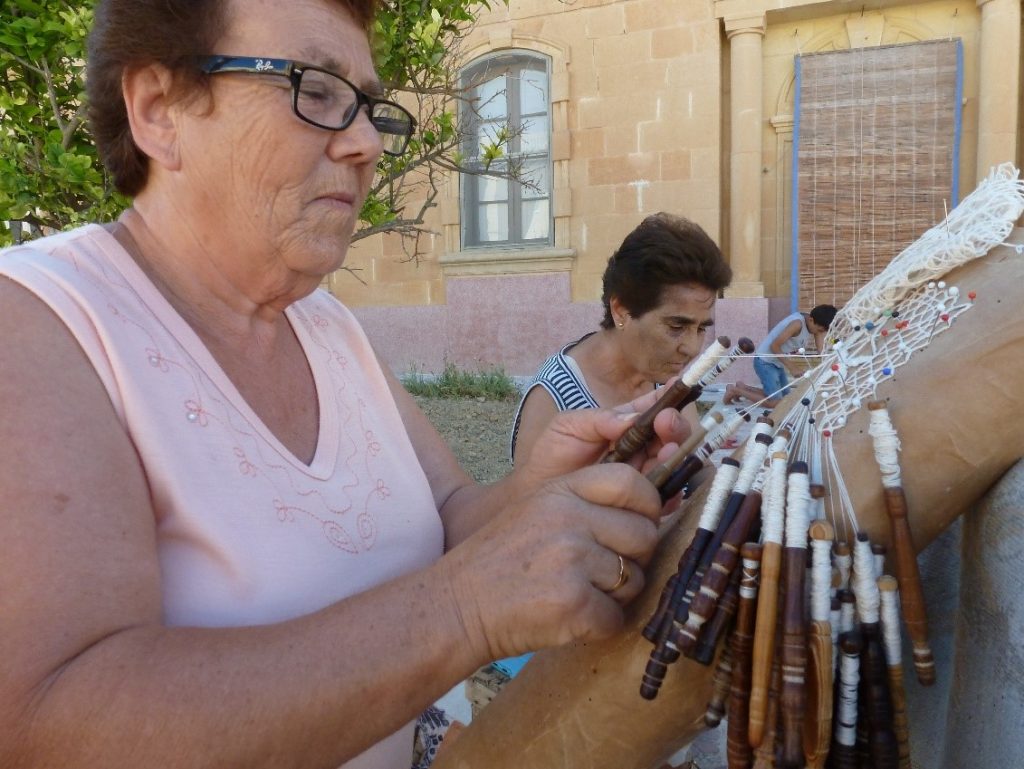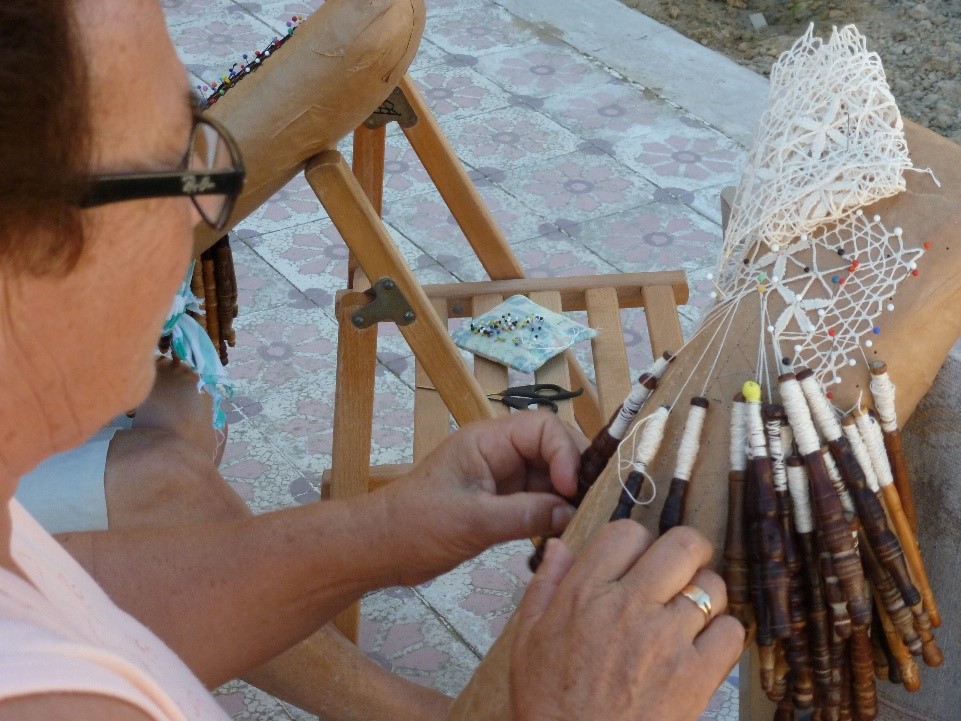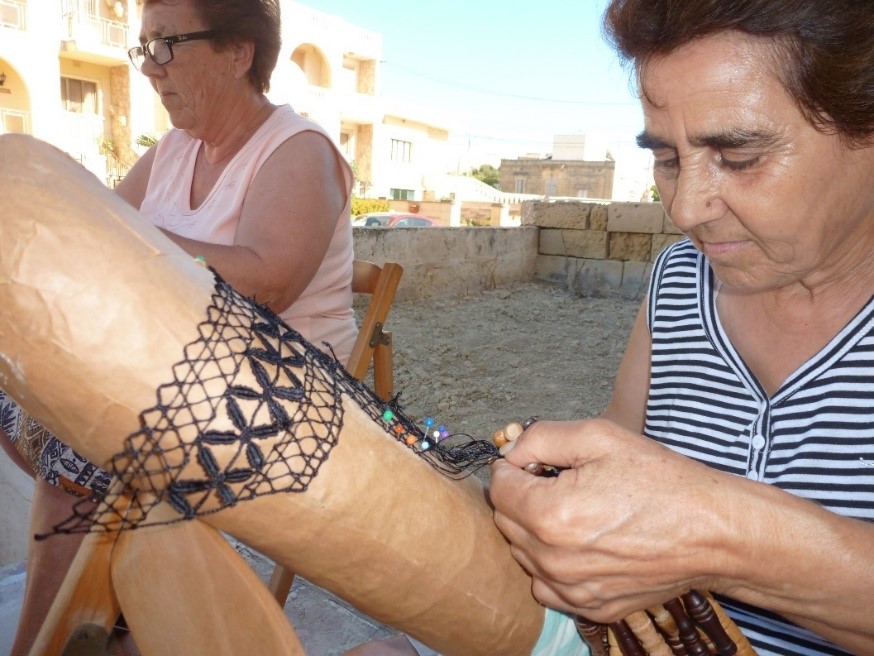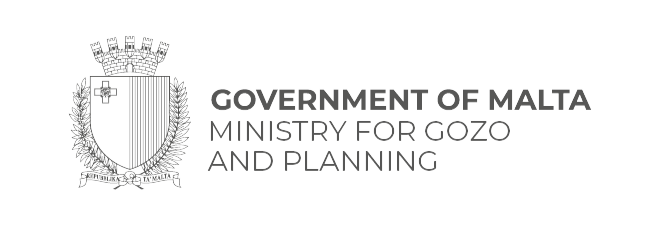Saunter down Gozo’s side streets on a hot summer evening while listening out for the click-clack of bobbins and you could end up witnessing one of the islands’ wonderfully talented lace-makers at work. Women, sat on their doorsteps patiently and diligently working the lace, using techniques and patterns passed down generations.
The delicate lace produced by these ladies is proudly displayed in our tourist shops, with ‘Gozo Lace’ renowned worldwide for its beauty, intricacy and authenticity.
The process: The ancient craft of lace making, known as ‘il-bizzilla’, became popular in Gozo around the mid 1840’s and is a style of bobbin lace made using silk or linen thread worked as a continuous piece onto a tall, thin, upright hard pillow called a ‘trajbu’ made from straw and paper.
The pattern for the lace is sketched onto parchment paper and holes are pricked indicating where to position the pins. The wooden bobbins hold threads which are quickly twisted and turned, crossing up and over one another with the thread held in place by the pins on the trajbu.
This lace-making process is a joy to watch. You’ll wonder at the speed in which these women work; the tension of their thread and their precision whilst stitching determines the quality of the lace created.
Lace stitched in linen is used for making household decor like table runners or centre pieces, whereas expensive silken lace is more often used for clothing such as bridal veils, baptism dresses and scarves; and historically this lace was used to adorn cuffs and collars.
SOME HISTORICAL FACTS ABOUT LACE
Pillow lace, first appeared in Genoa in 1530.
It’s believed lace was introduced to the Maltese islands by the Knights of St John, at the time lace was a popular clothing accessory for the elite.
The art of lacemaking was encouraged by the Church, who also used lace to embellish the clothing of the clergy. Lace was in high demand by the Knights, the church and members of the Maltese aristocracy; fueling a ‘cottage industry’ of local lace-makers. Lace-making became a valued source of income for many poor rural families.
The industry died out during the French occupation of our islands, but in the early 1800’s, when the Maltese islands became an important part of the British Empire; an English noblewomen Lady Hamilton Chichester arrived with Genoese lace-makers to help re-establish the craft. ‘Wheat ears’, a distinctive feature of Genoese lace were soon incorporated into local designs featuring an eight-pointed cross of St John which nowadays indicates the lace is of Gozitan /Maltese origin.
The British monarchy were great advocates of fine lace produced throughout the Maltese islands. In fact, during the 1830’s Queen Victoria ordered 16 pairs of long and short mits and a scarf.
(Photo for reference, may not be ‘Gozo Lace’)
(Photo for reference, may not be ‘Gozo Lace’)
During the peak of its popularity in the 18th century, fine lace was often smuggled from country to country because of sumptuary laws (laws restraining excessive consumption) and fine lace was considered as valuable as gold.
https://www.instagram.com/p/BWl-gJUl_kv/
Marjanna Attard is a name synonymous with Gozo Lace. During the 1840’s she was given a piece of lace by priest Dun Gwann Curmi, ‘tal-Grotta’. Marjanna scrutinized the lace, before teaching herself and her sister Ginisja how to recreate this design. Marjanna and Ginisja then went onto teach other local women the craft, who began earning money through lace-making. The sisters soon developed more elaborate patterns and stitches, their artistry in lacemaking was so exemplary their work was exhibited. In fact, it was Ginisja Attard who devised the famous ‘Mosche’ stitch which forms the petal shaped design still popular today.
By the mid 1850’s lace made throughout our islands was highly sought after and copied across Europe. In a relatively short amount of time, Gozitan women had excelled in this craft, many of them working in small family units.
In 1862 Gozo Lace came first in its category in the ‘International Exhibition of London’.
It’s claimed that by the end of the 1800’s there were around 4,500 women and girls lace-making across the Maltese islands, providing a valuable second income to their families.

Getting back to today, meet Mary-Jane Pace (74) and her sister Salvina (69) from Xewkija who have been lace-making since they were young girls, making an array of unique lace items for happy customers; from fine lace baptism dresses, bridal veils and scarves through to priest’s liturgical clothing, tablecloths and bookmarks. You name it, they have hand-crafted it.

Mary-Jane says: “My Grandmother taught me lace-making when I was 5 years old and Salvina and I have been making lace items for over 60 years. It was common for the daughters to be taught when they were young, so that they could help bring in extra money for their family. It was a very different time, if only you could have seen Xewkija back then there were always women and children sat in their gardens lacemaking. The money we earnt was really important. But today, Salvina and I enjoy it more as a hobby. Now it’s a relaxing and enjoyable way for us to spend our time once our household chores are over and done with.”

She continues: “Gozo Lace is famous worldwide and some of the lace items I have made have ended up in places as far away as Australia. There were times when rich people from foreign countries used to buy big pieces of lace from us. I remember an English man commissioning me to make a fine lace wedding veil for his bride to be. English people appreciate our skill and the work that is involved, they understand it takes us a lot of time to create such detailed, delicate designs”.
Although lacemaking isn’t as widely practiced as it was historically, there’s been a renewed enthusiasm for the craft, supported by events such as Gozo’s Annual Lace Day held at the University of Malta’s Gozo Campus which has a Lacemaking Programme. Click here for more information.
With thanks to: Chris Galea, Mary Jane Pace & Salvina Pace, J. Cassar Pullicino, Consiglia Azzopardi and Nicholas De Piro









